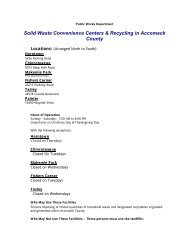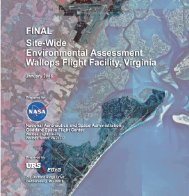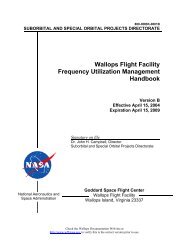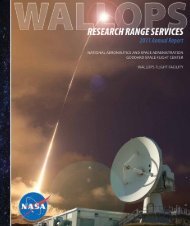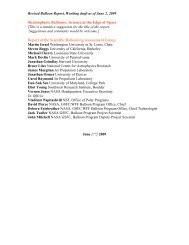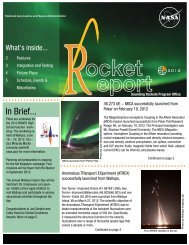Alternative Energy Draft EA - NASA Visitor Center at Wallops Flight ...
Alternative Energy Draft EA - NASA Visitor Center at Wallops Flight ...
Alternative Energy Draft EA - NASA Visitor Center at Wallops Flight ...
Create successful ePaper yourself
Turn your PDF publications into a flip-book with our unique Google optimized e-Paper software.
3.2.4.1 Birds<br />
Henslow’s Sparrow<br />
Affected Environment<br />
Henslow’s sparrow is a small bird characterized by a large fl<strong>at</strong>, striped olive-colored head, large<br />
gray bill, and short tail. In Virginia, they are rare transient, summer residents and winter visitors<br />
in the coastal plain with the only known summer occurrences in Accomack County. This species<br />
is believed to breed between May 15 and August 31 in neglected weedy fields commonly<br />
domin<strong>at</strong>ed by broom sedge, wet meadows, and the edges salt marshes. It occasionally inhabits<br />
dry and cultiv<strong>at</strong>ed uplands, may favor moist lowland habit<strong>at</strong> and may use areas with widely<br />
sc<strong>at</strong>tered shrubs. It prefers undisturbed non-maintained areas and breeds in a variety of grassland<br />
habit<strong>at</strong>s with tall, dense grass and herbaceous veget<strong>at</strong>ion. The nonbreeding habit<strong>at</strong> during<br />
migr<strong>at</strong>ion and winter includes moist grassy areas adjacent to open pine or second-growth forests.<br />
Upland Sandpiper<br />
Upland Sandpiper is medium-sized and the most terrestrial of North American shorebirds. Adults<br />
are overall scaly-brown in appearance above with a long slender neck, small rounded head, and<br />
large eye. Upland Sandpipers arrive in northern breeding areas in April/May and depart by<br />
September. Peak spring migr<strong>at</strong>ion through the U.S. Mid-Atlantic St<strong>at</strong>es occurs in April. In<br />
Virginia, they are rarely seen in spring and l<strong>at</strong>e fall along the coast, and mostly seen in early fall.<br />
The preferred habit<strong>at</strong> of the Upland Sandpiper consists of large open grasslands, gre<strong>at</strong>er than<br />
40.5 hectares (>100 acres), which are not extensively grazed or mowed and include large areas<br />
of short grass for feeding and courtship with interspersed or adjacent taller grasses for nesting<br />
and brood cover.<br />
Piping Plover<br />
Piping Plover is a small shorebird known to breed along the beaches of <strong>Wallops</strong> Island. Piping<br />
Plovers are small, beige and white shorebirds with a black band across their breast and forehead.<br />
The Plover breeds on coastal beaches from Newfoundland and southeastern Quebec to North<br />
Carolina, and winters primarily on the Atlantic Coast from North Carolina to Florida. Piping<br />
Plover habit<strong>at</strong> includes ocean beaches or sand or algal fl<strong>at</strong>s in protected bays, expansive sand<br />
fl<strong>at</strong>s, sandy mudfl<strong>at</strong>s, and sandy beaches. Nesting territories are establishing and courtship rituals<br />
are conducted beginning in l<strong>at</strong>e March or early April. Nests are situ<strong>at</strong>ed above the high tide line<br />
on coastal beaches, sandfl<strong>at</strong>s <strong>at</strong> the ends of sand spits and barrier islands, gently sloping<br />
foredunes, blowout areas behind primary dunes, and washover areas cut into or between dunes.<br />
The Piping Plover is known to nest on <strong>Wallops</strong> Island, and portions of the island are managed as<br />
protected areas by <strong>NASA</strong> (Figure 14). The northern and southern beaches have been closed to<br />
vehicle and human traffic during the Plover’s nesting season (March 15–September 1) since<br />
1986. Biologists from the CNWR monitor Piping Plover nesting activities and advise <strong>NASA</strong> on<br />
protection and management of the species. Biologists from the WFF USDA Wildlife Service<br />
Office aid with pred<strong>at</strong>or control.<br />
68




